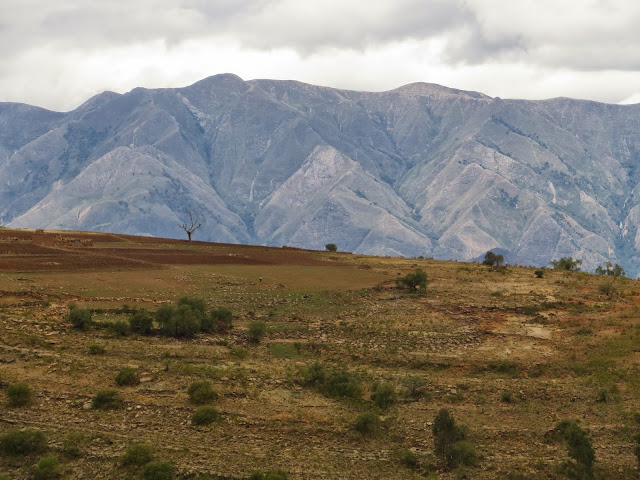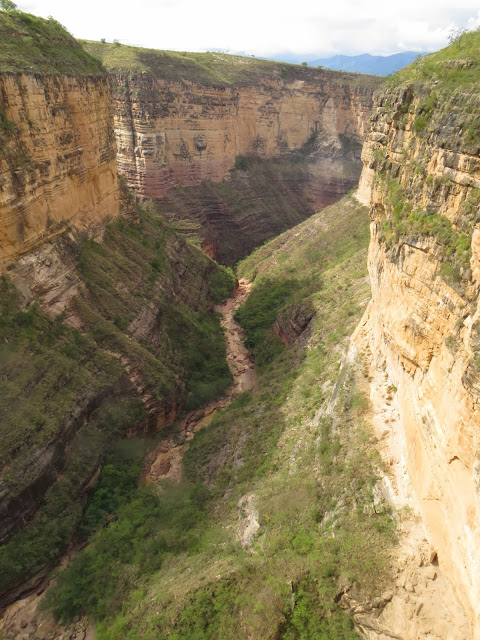Torotoro National Park
The view of dinosaurs' tracks excited me so much, that I decided to take a long bus travel (17 hours) to get to "la tierra de los dinosauros" : Torotoro National Park. The main reason why I came here was to see other dinosaurs footprint , but in few days I discovered that this park has much more to offer. The mountains have particular shapes and colours, due to millions of years of plaque movements, volcanos activities and water erosion. About 80-90 millions years ago, all this land was covered by the sea and marine fossils can be still found in the mountains. Later on, following the separation of the Pangea in different islands , the sea disappeared leaving a valley where dinosaurs and other animals grew up. About 70 millions years ago, dinosaurs extincted. In this area their extinction is due to different volcano eruptions, that reduced this valley in a dry land, burning all the vegetation. Herbivore dinosaurs died first, followed by the carnivorous ones. During these geological phenomenon, some of the dinosaur tracks were petrified leaving some holes in the rocks that only few years ago were identified as dinosaurs tracks. Some of them are quite little and you can clearly see a 3 toes footprint and they are attributed to young carnivorous dinosaurs. Other are very big, due to vegetarian dinosaurs.
You can see dinosaur footprints everywhere in Torotoro, even inside the village, sometimes you can even see tracks where there aren't... Every hole in the rock seems a footprint, so sometimes you just need to look at it for a while to understand if it's just a hole or something more. Walking in Torotoro made me feel a little bit like Alberto Angela (an Italian paleontologist), I could even hear his voice, with his unique way to explain different subjects and his hand gestures.
Besides dinosaurs tracks, Torotoro offers other attractions, like the cementerio de los tortugas (turtles cemetery, dated about 60 millions years ago), the trek siette vueltas (where it's possible to see tons of marine fossils (about 80 millions ago), la Ciudad de Itas (a rock formations with many caves), the cave of Umajallanta, El Vergel (a waterfall that lies inside a canyon).
For sure the most funny tour I took in these days is the one in the cave Umajallanta. I didn't know how was this tour, I imagined that we would easily enter in the cave, look at the stalagmites and stalactites and go out. I had no idea that I would have to jump from one rock to another, cross the river, walk in very narrow passages where a person a little bit fatter than me wouldn't pass and sometimes even slither like in the army exercises.
After the tour, our guide invited us to try the Chicha, a beverage made with fermented mais. I already tried in the past and I didn't really like it, so I just skip it. But all the other guys were very happy to try. Unfortunately no one liked it and one of the guy also felt bad the day after. Then the guide invited us to his house to listen some traditional music, play some local instruments and.. dancing with his mother. She doesn't speak Spanish, only quecha, but her energy was very contagious. Before leaving, the guide told us to meet at 7:30 am the day after for another tour. But at 7:30 no one showed up, nor the group, nor the guide. So I just went by myself looking for dinosaurs tracks. I found them just few meters outside the centre, some very very big. If you look at them singularly, they seem just holes in the rock, but when you see a group of tracks, you can really follow the dinosaurs walk. I went back to the agency, the guide arrived but the group didn't show up, so I took a private tour in the mountains near the city, where it's possible to see fossils. Everywhere you look, you could see a fossil, some quite big, others minuscule.
[Right now I'm writing from the bus from Torotoro to Cochabamba. The bus in front of us is stuck and we are stuck after it since more than one hour. In the last days it rained and now the road is impracticable. I had to take a collettivo 4x4 as I did on my way to Torotoro, but departure time was set between 11am and 4 pm (we had to wait that the car arrives from Cochabamba and then wait that the car is full before leaving and sometimes this can take hours).
Another wonderful trek is the one that took us to the canyon, to its mirador and then to the river. We didn't manage to get to the waterfall, because of the rain crossing the river was too dangerous. But it was still a nice hike.
I finally got to Cochabamba, 7.5h for 138 km, I think I said everything....

















































































































































Comments
Post a Comment